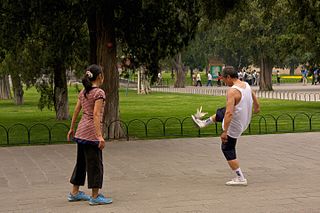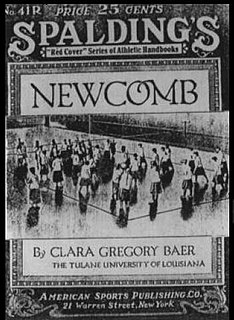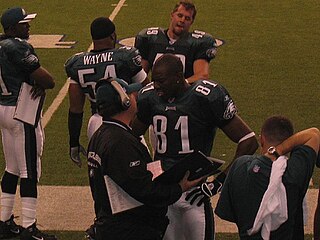
Rounders is a bat-and-ball game played between two teams. Rounders is a striking and fielding team game that involves hitting a small, hard, leather-cased ball with a rounded end wooden, plastic, or metal bat. The players score by running around the four bases on the field.

Sepak Takraw, or Sepaktakraw, also nicknamed kick volleyball, is a team sport played with a rattan between two teams of 2-4 players on a court resembling a badminton court. The sport shares similarities to both volleyball and footvolley with its use of a rattan ball and only allowing players to use their feet, knees, shoulders, chest and head to touch the ball.

A try is a way of scoring points in rugby union and rugby league football. A try is scored by grounding the ball in the opposition's in-goal area. Rugby union and league differ slightly in defining "grounding the ball" and the "in-goal" area.

Gridiron football, also known as North American football or, in North America, simply football, is a family of football team sports primarily played in the United States and Canada. American football, which uses 11-player teams, is the form played in the United States and the best known form of gridiron football worldwide, while Canadian football, featuring 12-player teams, predominates in Canada. Other derivative varieties include indoor football and Arena football, football for smaller teams, and informal games such as touch and flag football. Football is played at professional, collegiate, high school, semi-professional, and amateur levels.

Tchoukball is an indoor team sport developed in the 1970s by Swiss biologist Hermann Brandt. Brandt was concerned about the number of injuries in sport at the time and as part of an educational study he wanted to create a sport that reduced injuries, was not aggressive between players and enabled people of all shapes, sizes, genders, cultures, and backgrounds to play together.

Jianzi, tī jianzi (踢毽子), tī jian (踢毽) or jianqiú (毽球), is a traditional Chinese national sport in which players aim to keep a heavily weighted shuttlecock in the air by using their bodies, apart from the hands, unlike in similar games Peteca and Indiaca. The primary source of jianzi is a Chinese ancient game called Cuju of the Han dynasty 2,000 years ago. Jianzi's competitive sport types are played on a badminton court using inner or outer lines in different types of jianzi's competitive sports, respectively. It can also be played artistically, among a circle of players in a street or park, with the objective to keep the shuttle 'up' and show off skills. In Vietnam, it is known as đá cầu and is the national sport. In the Philippines, it is known as sipa and was also the national sport until it was replaced by arnis in December 2009. In recent years, the game has gained a formal following in Europe, the United States, and elsewhere.
Speedball is a fast-paced sport that combines many aspects of other sports. Points are scored by throwing or kicking the ball into the opposing goal. It is played with two teams of five or more, each with one goalie on a basketball court or soccer field.

The team sports rugby union and rugby league have shared origins and thus many similarities.
Several sports related to volleyball have become popular. Indoor volleyball and beach volleyball are both events at the Olympics, and sitting volleyball is an event at the Paralympics. Other varieties are localised, or are played at an amateur or informal level.
Traditional Filipino games or indigenous games in the Philippines are games commonly played by children, usually using native materials or instruments. In the Philippines, due to limited resources for toys, Filipino children usually invent games without needing anything but the players themselves. Their games' complexity arises from their flexibility of thought and action.

Newcomb ball is a ball game played as a variation of volleyball.
A penalty in rugby union is the main disciplinary sanction available to the referee to penalise a team who commit deliberate infringements. The team who did not commit the infringement are given possession of the ball and they may either kick it towards touch, attempt a place kick at goal, or tap the ball with their foot and run. It is also sometimes used as shorthand for penalty goal.

In sports, out of bounds refers to being outside the playing boundaries of the field. Due to the chaotic nature of play, it is normal in many sports for players and/or the ball to go out of bounds frequently during a game. The legality of going out of bounds, and the ease of prevention, vary by sport. In some cases, players may intentionally go or send the ball out of bounds when it is to their advantage.

Sepak raga is a traditional Indonesian and Malaysian sport, developed in the Malay Archipelago. This game is related to the modern sepak takraw. Similar games include footbag net, footvolley, bossaball and jianzi.

Woggabaliri is a traditional Indigenous Australian "co-operative kicking volley game".
Netball is a ball sport for two teams of seven players; its rules are published in print and online by the International Netball Federation. Games are played on a rectangular court divided into thirds, with a raised goal at each short end. The objective of the game is for teams to score goals, by passing a ball and shooting it into the opposite team's goal ring. Players are assigned "positions" that define their role within the team and restrict their movement on court.

Circle rules football, commonly referred to as circle rules, is a team sport played between two teams of six with a large spherical ball similar to a stability ball. Invented in New York City in 2006, the sport is currently played in cities across the United States, as well as in several international locations.

A footbag is a small, round bag usually filled with plastic pellets or sand, which is kicked into the air as part of a competitive game or as a display of dexterity. "Hacky Sack" is the name of a brand of footbag popular in the 1970s, which has since become a generic trademark.

Comparison of association football (football/soccer) and rugby union (rugby/rugger) is possible because of the games' similarities and shared origins.

Punjabis play a wide variety of sports and games, ranging from modern games such as hockey and cricket, to the more traditional games such as Kabaddi, Kushtian (wrestling) and Khuddo khoondi. There are over 100 traditional games and sports of Punjab.















